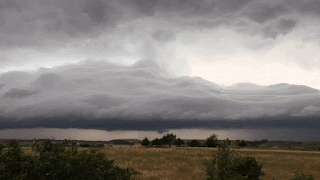I'm sure that many, especially those who reside near the coasts or mountains rather than "flyover states," may not understand my self-enforced and barely-borne tolerance of the trials and tribulations stemming from gardening in the Kansas climate. Certainly my parents, from rich- and fertile-soiled Indiana, have occasionally expressed their lack of appreciation of the charms of Kansas. I feel, therefore, obligated to show you a few photos that I've taken just in the past two weeks, lest you think that ProfessorRoush is entirely crazy. For starters, this is a panorama of the view to my east a few mornings back as I was taking Bella out for an early stroll:

How could I possibly ask for a better greeting and start to my day? Such sunrises are not at all unusual, pink clouds chased by warm sunshine until the entire sky glows.
 A night or two later, it was this double rainbow that appeared, to my south, rain in the distance chased away by the setting western sun. I've seen double rainbows on two occasions in the last month, and it has only rained twice all month!
A night or two later, it was this double rainbow that appeared, to my south, rain in the distance chased away by the setting western sun. I've seen double rainbows on two occasions in the last month, and it has only rained twice all month!
Sometimes, it seems as if Mrs. ProfessorRoush tries to rouse me off the couch every evening at sunset, wanting me to take a "real" photo of a sunset instead of using an iPhone. I actually often complain about how frequently my restful postprandial lethargy is interrupted by her enthusiastic worship of the sky. I haven't yet mentioned the existence of Tengrism to her, for fear that she may forsake her Christian background to join others in formal worship of the Eternal Blue Sky. The photo below is a wider panorama taken slightly before the photo at the left.
There are also those mornings where the beauty of the day stems from atmospheric turmoil more than the beneficent touch of the sun. A few days ago, there was an entirely different appearance to the same morning view of the northeastern sky that I showed you in the first photo on this page. A little past 5 a.m. Central, the rising sun and distant sky was a backdrop to these very low, fast-moving wisps of cloud. This time-lapse is taken over about 15 seconds as I tried to hold the camera still. There was no rain or moisture, just these strange clouds moving opposite the high altitude flow.
Of course, what I've left out of all these pictures is the almost constant sunshine and moderately cloud-free days of this climate. Manhattan, Kansas may not have one of the most sunny climates in the world, but officially we are around 240 days of sunshine a year, less then I would estimate (I figured it was over 300), but about 60 days more than Indiana/Ohio/Wisconsin where I've previously lived. The picture below was taken Friday, June 30th, as I wrote this blog entry, when I realized that I haven't archived pictures of the "normal" sky, just the stormy scenes. So, at random, this is yesterday, 3:00 p.m., taken right outside my front door, and you can consider it a "normal" Kansas sky. Maybe those "Tengrists" aren't too far out on a spritual limb after all.















































